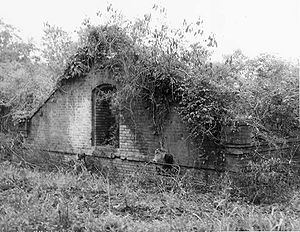Siege of Fort St. Philip (1815)
| Siege of Fort St. Philip | |||||||
|---|---|---|---|---|---|---|---|
| Part of battle of New Orleans and War of 1812 | |||||||
 Fort St. Philip, overgrown in the mid 20th century |
|||||||
|
|||||||
| Belligerents | |||||||
|
|
|
||||||
| Commanders and leaders | |||||||
|
|
|
||||||
| Strength | |||||||
|
Land: Unknown Sea: 1 sloop-of-war 1 brig-of-war 1 schooner 2 bomb vessels Unknown armed boats |
163 infantry 84 militia 40 sailors 117 artillery 35 artillery pieces 1 fort Total: 406 |
||||||
| Casualties and losses | |||||||
| 1 bomb vessel damaged Unknown armed boats damaged |
2 killed 7 wounded 1 fort damaged |
||||||
American victory;
The Siege of Fort St. Philip was a battle taking place during the ending of the War of 1812 between a sizable British naval fleet attempting to sail the Mississippi River by force in order to provide reinforcements to British forces already attacking New Orleans as part of the Louisiana Campaign, and the single American garrison of Fort St. Philip guarded by a far numerically-inferior force. The siege lasted from January 9 to January 18, 1815.
The Royal Navy had begun the Louisiana Campaign to capture New Orleans. However, to reach New Orleans, the destruction of the small U.S. Navy squadron in the area and the U.S. Army forts and batteries was necessary. Fort St. Philip, an irregular work guarding the Mississippi River, the body of a parallelogram, was one of the said forts.
The fort mounted twenty-nine 24-pound cannons, two 32-pound cannons, and two howitzers, an 8-inch and a 5.5-inch. One 13-inch mortar and another 6-pound cannon were also used. Thirty-five pieces in all were used. The Americans had 163 infantry, 84 white and freed African-American militia and 117 artillery men to man the fort's armaments.
In December 1814, American forces were warned of an approaching British flotilla off Louisiana. This encouraged the garrison of Fort St. Philip to begin constructing better defenses such as a battery on the opposite side of the Mississippi, which would support the two said 32-pound cannons and the 18-inch mortar; the battery was not finished though by the time the British flotilla arrived and was abandoned during the engagement.
The Americans built a signal station three miles below the installation and an earthen redoubt to defend the fort's rear side in case of a land assault. They also erected overhead cover above the fort's gun batteries to prevent shell fragments from hitting the gun-crews. The gunners repaired the worn-out U.S. artillery carriages and moved some to other batteries in the fort. They destroyed the old powder magazine, replacing it with several additional magazines that they built, which had wood and dirt piled on top to protect them. The idea was that if one powder magazine was destroyed, the others would still be usable.
...
Wikipedia
